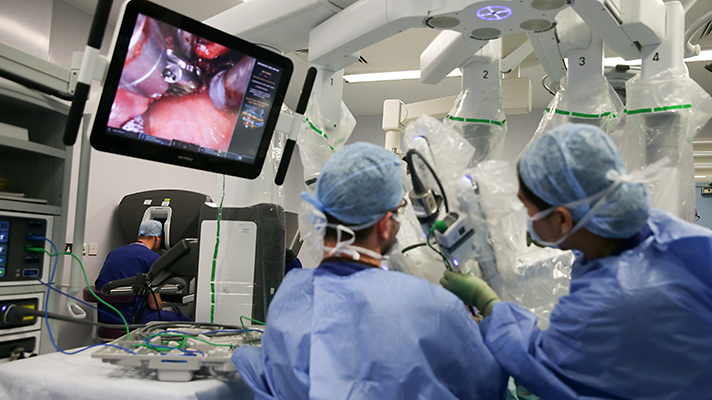Revolutionizing Healthcare: Robotics in the Surgery Industry
Title: Revolutionizing Healthcare: Robotics in the Surgery Industry
Introduction:
The marriage of robotics and healthcare has ushered in a new era of precision, efficiency, and innovation, particularly in the field of surgery. Robotic-assisted surgery, once confined to science fiction, has become a reality, transforming the way surgeries are performed and redefining patient outcomes. This article explores the burgeoning role of robotics in the surgery industry, examining its evolution, applications, benefits, challenges, and the future trajectory of this groundbreaking technology.
Evolution of Robotic Surgery:
The roots of robotic surgery can be traced back to the late 20th century, with the development of pioneering systems such as the PUMA 560, which assisted in neurosurgical procedures. However, it was the introduction of the da Vinci Surgical System in the early 2000s that catalyzed a paradigm shift in surgical practices. Developed by Intuitive Surgical, the da Vinci System combined robotic technology with advanced imaging and instrumentation, enabling surgeons to perform minimally invasive procedures with enhanced precision and dexterity.
Applications of Robotic Surgery:
Robotic surgery encompasses a diverse array of medical specialties and procedures, ranging from cardiac and urological surgeries to gynecological and orthopedic interventions. Some notable applications include:
1. Prostatectomy: Robotic-assisted laparoscopic prostatectomy has emerged as a gold standard for the treatment of prostate cancer, offering improved oncological outcomes, reduced blood loss, and faster recovery times compared to traditional open surgery.
2. Cardiovascular Surgery: Robotics is revolutionizing cardiac surgery, with robotic systems facilitating complex procedures such as mitral valve repair, coronary artery bypass grafting, and atrial septal defect closure with unparalleled precision and minimally invasive access.
3. Gynecological Surgery: Robotic-assisted hysterectomy and myomectomy have gained popularity in the field of gynecology, enabling surgeons to perform intricate procedures with greater dexterity and visualization, leading to shorter hospital stays and decreased postoperative pain.
4. Orthopedic Surgery: In orthopedics, robotics aids in total knee arthroplasty and total hip replacement surgeries, allowing for precise implant placement, alignment, and soft tissue balancing, thereby improving functional outcomes and longevity of prosthetic joints.
Benefits of Robotic Surgery:
The integration of robotics into the surgical landscape offers a multitude of benefits for patients, surgeons, and healthcare institutions alike:
1. Enhanced Precision: Robotic systems provide surgeons with unprecedented precision and control, allowing for meticulous tissue dissection, suturing, and manipulation in confined anatomical spaces, thereby reducing the risk of complications and improving surgical outcomes.
2. Minimally Invasive Approach: Robotic-assisted surgery minimizes trauma to surrounding tissues and organs, as it requires smaller incisions compared to traditional open surgery. This results in reduced blood loss, decreased postoperative pain, faster recovery times, and shorter hospital stays for patients.
3. Improved Visualization: High-definition 3D imaging and magnification capabilities offered by robotic systems afford surgeons a detailed and immersive view of the surgical field, enhancing spatial awareness and facilitating precise anatomical identification and dissection.
4. Surgeon Ergonomics: Robotic surgery alleviates the physical strain and fatigue experienced by surgeons during prolonged procedures, as it enables ergonomic positioning and intuitive instrument manipulation through console-based control interfaces.
Challenges and Considerations:
Despite its transformative potential, robotic surgery presents certain challenges and considerations that warrant attention:
1. Cost: The initial capital investment required to procure and maintain robotic surgical systems can be substantial, posing financial barriers for healthcare institutions, particularly in resource-constrained settings. Additionally, the ongoing expenses associated with instrument maintenance, training, and system upgrades contribute to the overall cost of robotic surgery.
2. Learning Curve: Mastery of robotic surgical techniques necessitates extensive training and proficiency, as surgeons must acquire proficiency in navigating the robotic console, interpreting 3D imaging, and translating hand movements into precise robotic actions. The learning curve associated with robotic surgery may vary among surgeons, potentially impacting surgical outcomes during the initial adoption phase.
3. Access and Equity: Disparities in access to robotic surgery exist across geographic regions and healthcare systems, with patients in rural or underserved areas facing challenges in accessing specialized robotic procedures. Ensuring equitable distribution and affordability of robotic surgical services is essential to mitigate healthcare disparities and promote universal access to high-quality surgical care.
Future Directions:
The future of robotic surgery holds promise for continued innovation and refinement, with several trends and advancements poised to shape its trajectory:
1. Artificial Intelligence Integration: The integration of artificial intelligence (AI) algorithms and machine learning capabilities into robotic surgical systems holds the potential to enhance procedural automation, predictive analytics, and decision support, thereby optimizing surgical workflows and improving patient outcomes.
2. Miniaturization and Mobility: Advancements in robotics technology are driving the miniaturization of surgical robots and the development of portable, modular systems that can be deployed in diverse clinical settings, including ambulatory surgery centers, remote healthcare facilities, and disaster relief scenarios.
3. Haptic Feedback and Sensory Augmentation: Future robotic surgical platforms may incorporate haptic feedback mechanisms and sensory augmentation technologies to provide surgeons with tactile feedback and real-time sensory information, mimicking the tactile sensation and proprioception of traditional manual surgery.
Conclusion:
Robotic surgery represents a transformative paradigm shift in the field of surgery, offering unparalleled precision, minimally invasive access, and improved patient outcomes. As robotics continues to evolve and permeate various surgical disciplines, addressing challenges related to cost, training, and access will be paramount to realizing its full potential and ensuring equitable delivery of surgical care worldwide. By embracing innovation, fostering interdisciplinary collaboration, and prioritizing patient-centric outcomes, the integration of robotics into the surgery industry holds the promise of shaping a brighter future for global healthcare.


